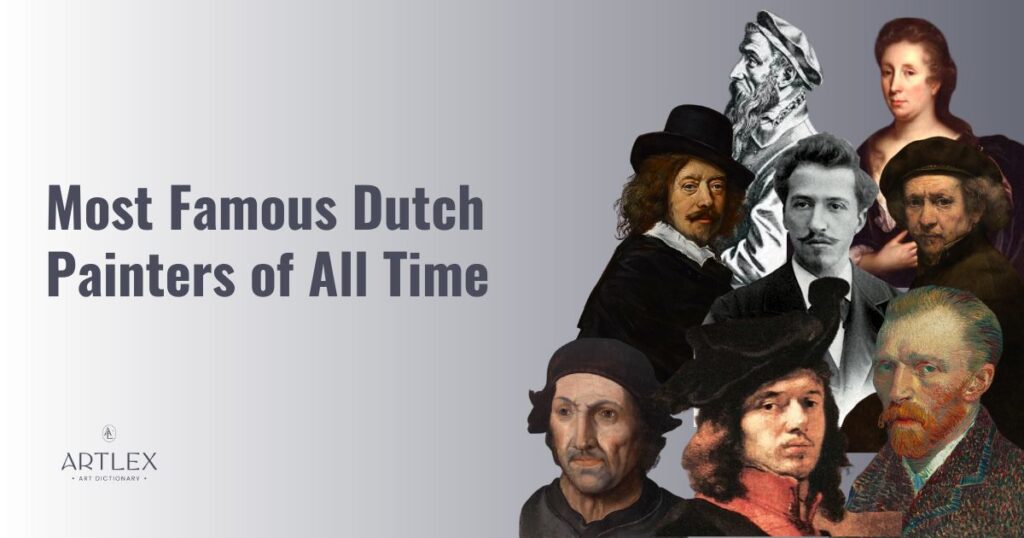The art of the Netherlands is world-renowned for its emphasis on realism, light manipulation, and unique perspective on everyday life. Famous Dutch painters like Rembrandt, Vermeer, and Van Gogh have shaped how we perceive art, defining styles that transcended borders and inspired generations. Each painter brought something new, from mastery of chiaroscuro (light and shadow) to vibrant color palettes and deep emotional resonance. Their legacy continues to shine today, captivating audiences globally. Let’s explore these 10 Dutch Masters who forever changed the artistic landscape.
Rembrandt van Rijn: The Master of Light and Shadow
One of the most famous Dutch painters of all time, Rembrandt van Rijn, revolutionized portrait painting through his meticulous use of light and shadow. Born in 1606, Rembrandt’s works convey deep psychological insight and a striking realism that resonates with viewers centuries later. His masterpiece, The Night Watch, showcases his exceptional ability to capture movement, emotion, and atmosphere.
Through his use of chiaroscuro, Rembrandt breathed life into his subjects, making him a central figure in Dutch Golden Age painting. His portraits, biblical scenes, and self-portraits remain timeless examples of technical brilliance and emotional depth.
Johannes Vermeer: The Poet of Light
Johannes Vermeer, another towering figure among famous Dutch painters, is celebrated for his exquisite use of light and color. His iconic work, Girl with a Pearl Earring, epitomizes his ability to capture fleeting moments of beauty. Vermeer’s attention to detail, along with his subtle yet powerful compositions, creates an intimate portrayal of Dutch domestic life.
What sets Vermeer apart is his mastery of light. He used it not only to illuminate his subjects but also to create atmosphere and emotion. His works are timeless, allowing viewers to step into the serene and quiet world of 17th-century Holland.
Vincent van Gogh: The Post-Impressionist Visionary
No list of famous Dutch painters would be complete without Vincent van Gogh, the artist who revolutionized modern art with his bold use of color and emotional intensity. Known for works like Starry Night and Sunflowers, Van Gogh’s expressive brushstrokes and vibrant palette conveyed his inner turmoil and passion.
Van Gogh’s life was marked by personal struggles, but his ability to transform his emotions into powerful art is what makes him one of the greatest artists of all time. His work laid the foundation for Expressionism and influenced countless artists who followed.
Frans Hals: The Painter of Lively Portraits
Frans Hals, a pioneer of the Golden Age, is best known for his lively and energetic portraits. His loose, vibrant brushwork gives his subjects a sense of immediacy and character. The Laughing Cavalier is perhaps his most famous painting, capturing not just the likeness of the subject, but a joyful, carefree spirit.
As one of the more unconventional famous Dutch painters, Hals’s style contrasted with the highly polished portraits of his contemporaries. His ability to convey personality and spontaneity through his work makes him a beloved figure in art history.
Piet Mondrian: The Pioneer of Abstract Art
Piet Mondrian, one of the most influential famous Dutch painters of the 20th century, is known for founding the De Stijl movement, which focused on abstract art and simplicity. Mondrian’s use of geometric shapes, primary colors, and bold lines in works like Composition with Red, Blue, and Yellow redefined what painting could be.
His minimalist, non-representational style revolutionized modern art, influencing architecture, design, and fashion. Mondrian’s pursuit of “pure abstraction” reflects a philosophical quest for universal beauty and harmony through art.
Hieronymus Bosch: The Master of Fantasy and Religious Imagery
Hieronymus Bosch is among the most enigmatic and imaginative famous Dutch painters in history. His surreal and often disturbing imagery, as seen in works like The Garden of Earthly Delights, continues to fascinate viewers. Bosch’s paintings are filled with fantastical creatures, moral lessons, and intricate symbolism that reflect the religious and philosophical concerns of his time.
His unique style set him apart from his contemporaries and established him as a pioneer of fantasy art, with a profound influence on both modern and contemporary surrealist movements.
Jacob van Ruisdael: The Landscape Virtuoso
One of the most skilled landscape painters of the Dutch Golden Age, Jacob van Ruisdael is widely regarded as the master of depicting natural beauty. His works, such as View of Haarlem with Bleaching Fields, exemplify his talent for creating vast, atmospheric landscapes with dramatic skies and finely detailed environments.
Ruisdael’s ability to capture the majesty of nature, combined with his delicate handling of light and shadow, places him among the most revered famous Dutch painters in the landscape genre. His work paved the way for future landscape artists to explore and appreciate nature’s grandeur.
Jan Steen: The Storyteller of Dutch Genre Painting
Jan Steen was a Dutch Golden Age painter known for his lively, often humorous depictions of domestic life. His scenes of rowdy households, taverns, and festivals provide an entertaining glimpse into 17th-century Dutch society. One of his best-known works, The Feast of Saint Nicholas, humorously captures the chaos and joy of a family celebration.
Steen’s storytelling ability, combined with his vibrant compositions, earned him a place among the most notable famous Dutch painters. His works often conveyed moral lessons, yet they remain relatable and amusing, making him a beloved figure in art history.
Gerrit Dou: The Finer Details of Everyday Life
As one of the leading figures of the Leiden School of fine painters, Gerrit Dou excelled in the detailed depiction of everyday life. His intricate works, such as The Grocer’s Shop, showcase his extraordinary ability to render textures and materials with precision.
Dou’s mastery of light and his attention to fine detail secured his reputation among the famous Dutch painters. His works were highly sought after, especially by wealthy patrons, for their beauty and meticulous craftsmanship.
Willem de Kooning: The Abstract Expressionist Force
Although Willem de Kooning spent much of his career in the United States, his Dutch roots influenced his development as one of the 20th century’s leading abstract expressionists. De Kooning’s dynamic, expressive style, as seen in his Woman series, challenged traditional notions of form and beauty.
His bold brushstrokes and intense use of color helped establish him as a key figure in abstract art. De Kooning’s contribution to modern art cements his legacy as one of the most impactful famous Dutch painters, bridging the gap between European and American art movements.
Conclusion
The contributions of famous Dutch painters are unparalleled, shaping the evolution of art from the Renaissance to modern times. Their mastery of technique, emotion, and innovation continues to inspire artists and art lovers alike. Whether through the emotive realism of Rembrandt, the luminous beauty of Vermeer, or the bold abstraction of Mondrian, these painters have left a profound legacy. Their works are a testament to the genius and creativity that defined the Dutch art tradition.
FAQs
Q1. Who is considered the most famous Dutch painter?
Rembrandt is often considered the most famous Dutch painter, known for his mastery of light and shadow, as seen in works like The Night Watch.
Q2. What is the Dutch Golden Age in art?
The Dutch Golden Age refers to a period in the 17th century when Dutch art, trade, science, and military prowess were among the most celebrated in the world. This era produced many renowned painters, including Rembrandt, Vermeer, and Frans Hals.
Q3. How did Vincent van Gogh influence modern art?
Vincent van Gogh’s use of vibrant colors and expressive brushstrokes laid the groundwork for modern art movements like Expressionism, making him one of the most influential Dutch painters.
Q4. What is the significance of Vermeer’s Girl with a Pearl Earring?
Girl with a Pearl Earring is one of Vermeer’s most celebrated works, known for its captivating portrayal of light, color, and emotional depth, solidifying his place among Dutch art masters.
Q5. How did Piet Mondrian change the art world?
Piet Mondrian’s abstract style, particularly through the De Stijl movement, revolutionized art by focusing on geometric forms and primary colors, influencing design, architecture, and modern aesthetics.
Also read: Oud West Neighborhood Amsterdam: 10 Authentic Dining Spots You’ll Love





